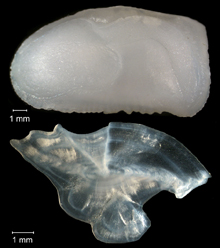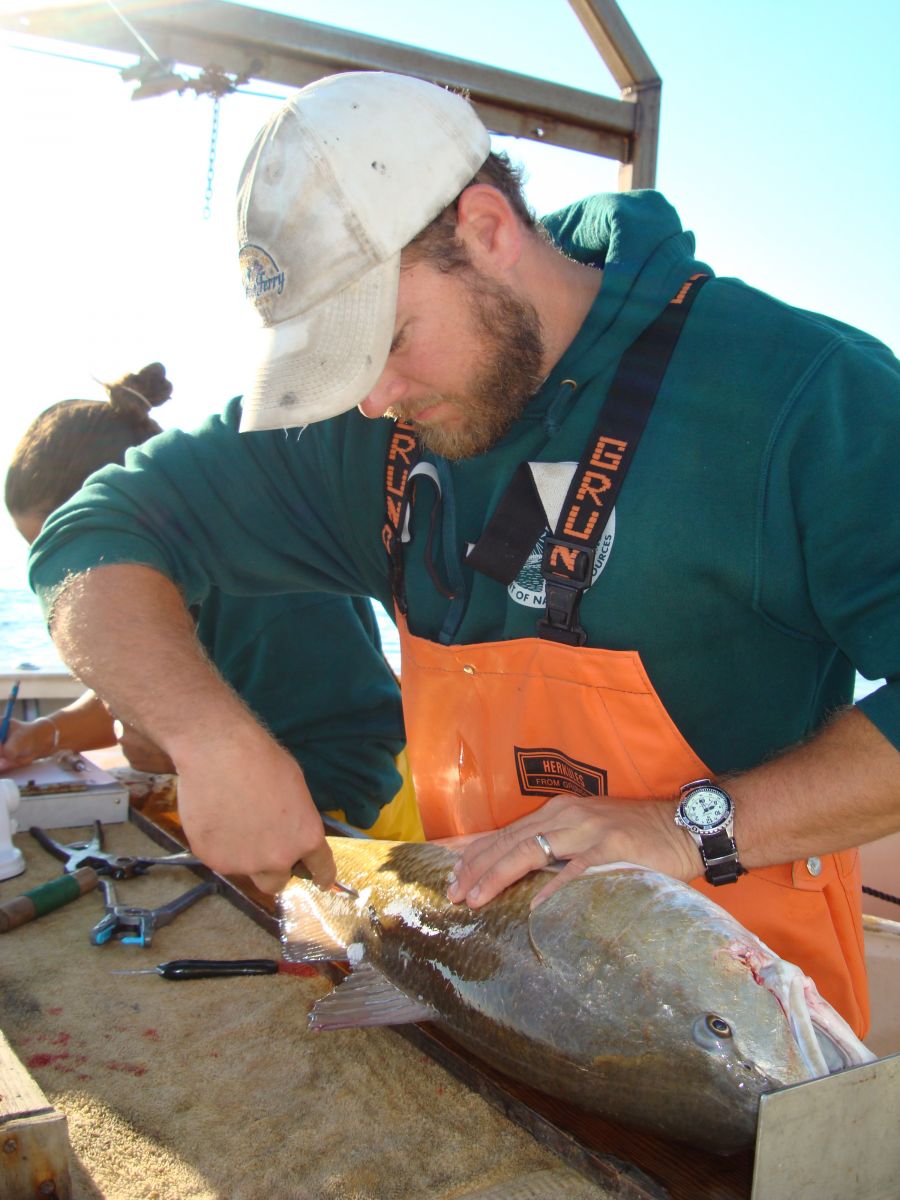Fisheries Research
The Commission’s Fisheries Science Program coordinates activities of state and federal fishery management agencies in order to improve the scientific basis of fisheries management decisions. Research activities cover a broad range of scientific issues that can be applied to several species. Conventional research in fish ageing and tagging improves population modeling. Innovative research in genetics and climate change answer fisheries managers’ questions regarding stock structure and the changing distribution of stocks.
Ageing
Ageing data can be an important component to describe the life history of a fish, such as growth, or as an input to age-structured stock assessment model. Fisheries biologists determine the age of a fish by counting annual markings of growth observed on one or more body parts. The most commonly used ageing structures are fish scales, otoliths (ear bones), opercula (gill plates), spines, and vertebrae. Annual markings form because fish grow at different rates during the warm (faster) and cool (slower) seasons, producing alternating translucent and opaque bands on an ageing structure. These marks can be read in the same way that rings are counted to age trees.
Fish age information is the basis for determining how fast a species grows, how long it lives, when it matures, and the size at each age. Understanding how fast fish grow and when they mature allows scientists to develop harvest strategies that allow the population to successfully replace what was removed by fishing and natural causes. A variety of harvest strategies may be evaluated by comparing different gear sizes that capture different ages of fish. The gear size catching the preferred ages of fish may then be implemented to meet management goals. Age data also provide important information on the age structure, or demographics, of a fish population and whether that age structure is changing over time.
Obtaining quality age data can be challenging and expensive. Ageing methods must be validated using controlled laboratory or tagging studies to confirm that observed markings are truly annual markings (annuli). Collecting age data requires a sampling program that adequately covers the fishery or stock, and scientists and facilities to process samples.
The Commission organizes workshops to address important questions related to fish ageing techniques. Several state agencies collect age samples for a species or group of related species and meet to compare methods. Ageing experts from each state review sample processing procedures and exchange samples for age reading comparisons. The goal is to ensure age samples are being processed and read in a consistent manner coast wide, providing reliable data for use in assessments of finfish populations. To date, the Commission has conducted ageing workshops on American shad, river herring, American eel, Atlantic croaker and red drum, Atlantic menhaden, Atlantic striped bass, black sea bass, bluefish, tautog, and winter flounder. Since 2016, the Commission has held an annual Fish Ageing Quality Assurance/Quality Control Workshop among ageing lab experts from Maine to Florida to maintain ageing consistency for species that have had a standalone workshop.
Contacts
Kristen Anstead, Ph.D., Stock Assessment Scientist
Documents
2024 Report of the Quality Assurance/Quality Control Fish Ageing Workshop (March 2024)
2023 Report of the Quality Assurance/Quality Control Fish Ageing Workshop (March 2023)
Summary of the 2020-2021 Tautog Ageing Sample Exchange (September 2021)
A Practical Handbook for Determining the Ages of Gulf of Mexico and Atlantic Coast Fishes (November 2020)
2019 Report of the Quality Assurance/Quality Control Fish Ageing Workshop (March 2019)
2018 Report of the Quality Assurance/Quality Control Fish Ageing Workshop (March 2018)
2017 Report of the Quality Assurance/Quality Control Fish Ageing Workshop (May 2017)
American Eel Ageing Report (May 2017)
Report of the Quality Assurance/Quality Control Fish Ageing Workshop (March 2016)
Atlantic Menhaden Ageing Workshop Report (June 2015)
River Herring Ageing Workshop Report (August 2014)
Proceedings of the 2013 Black Sea Bass Ageing Workshop (December 2013)
Tautog Ageing Workshop Report (May 2012)
Proceedings from the Winter Flounder Ageing Workshop (February 2012)
Bluefish Ageing Workshop Report (May 2011)
Proceedings from the Atlantic Croaker and Red Drum Ageing Workshop (October 2008)
Proceedings from the Atlantic Striped Bass Ageing Workshop (March 2003)
Testing the validity of Cating’s (1953) method for age determination of American shad using scales. Fisheries Research 30: 10-18.McBride, R.S., Hendricks, M.L., and Olney, J.E. (2005)
Proceedings of the Workshop on Ageing and Sexing American Eel (December 2001)
Tagging
Tag and recapture data are valuable inputs to the stock assessments of several species managed by the Commission, including Atlantic striped bass, red drum, Atlantic cobia, Atlantic sturgeon, weakfish, spiny dogfish, and coastal sharks. The Commission’s Interstate Tagging Committee (ITC) was created in 1999 to improve the quality and utility of fish tagging data. A subcommittee of ITC members with expertise in tagging program design was established to review and certify interested tagging programs. The certification process supports the promotion of effective tagging programs that can contribute to stock assessments. The ITC maintains a Cooperative Tagging Website and Registry that provides information on coastwide tagging programs. Anglers can search a database by fish species, tag type, and tag color in order to identify recovered tags. The tagging program certification application is also available on the tagging website.
Since 1988, the Commission has partnered with state and federal agencies and academic institutions on a Cooperative Winter Tagging Program led by the U.S. Fish and Wildlife Service. The program organizes scientists to conduct field tagging of striped bass aboard a charter boat each winter in nearshore waters off Virginia and North Carolina.
During tagging activities, fish lengths are measured at the time of initial tagging and then measured again during subsequent recapture to provide information on growth. The proportion of fish recaptured over different time periods provides information on survival and mortality. Lengths of fish recaptured by recreational anglers and released alive provide information on the size composition of the recreational catch. Some fish are assumed to die post-release due to hooking and handling stress and contribute to fishing mortality rate estimates in stock assessments. Tagged fish that are recaptured also provide scientists with information to better understand habitat preferences, seasonal movements and migrations, and stock boundaries.
A rapidly growing area of tagging research and data is acoustic telemetry. Acoustic transmitters are attached or implanted in fish and subsequently emit a unique sound, or ping, detected and recorded as the fish pass by receivers strategically placed to answer questions about migration patterns and survival. Several networks have developed to facilitate telemetry data sharing and collaboration amongst researchers, including the Atlantic Cooperative Telemetry Network (ACT, https://www.theactnetwork.com/), the FACT Network (https://secoora.org/fact/), and the Mid-Atlantic Acoustic Telemetry Observation System (MATOS, https://matos.asascience.com/). Data from telemetry tagging research have improved our understanding of life history and advanced stock assessment techniques of Commission-managed species, including Atlantic sturgeon, Atlantic striped bass, and Atlantic cobia.
Contacts
Jeff Kipp, ASMFC Senior Stock Assessment Scientist
Additional Information
Cooperative Tagging Website and Registry
Gear Technology
The Commission established the Fishing Gear Technology Work Group (FGTWG) to evaluate new gear innovations and associated research to assess their potential to reduce bycatch, discarding, and habitat alteration associated with Atlantic coast fisheries. The Workgroup, comprised of fishing gear experts from state agencies, academic institutions, and NOAA Fisheries, is building on the Commission’s history of improving fishing gear to minimize impacts on ecosystems. Earlier efforts by Commission committees and workgroups contributed to implementation of the Nordmore grate, turtle exclusion devices (TEDs), and finfish bycatch reduction devices (BRDs) in a variety of fisheries along the Atlantic coast.
In 2008, the FGTWG identified priority fisheries and completed evaluations of gear technology to address issues in these fisheries. The Work Group’s findings are available in the 2009 FGTWG Report.
Contacts
Jeff Kipp, Stock Assessment Scientist
Documents
Report of the Fishing Gear Technology Work Group to the Management and Science Committee (November 2009)
Additional Research Documents
Atlantic Sturgeon Research Techniques (July 2010)
Guidelines for Stocking Cultured Atlantic Sturgeon for Supplementation or Reintroduction (February 2006)
Partnerships
Collaborative partnerships are the cornerstone of the Commission’s management, science, habitat, and data collection programs. The Commission itself is a partnership of the 15 Atlantic coast states and was established with the recognition that the states needed to join forces to ensure the sound conservation and management of their shared coastal fishery resources and the resulting benefits to the fishing and non-fishing public. Further, the states have found that their mutual interest in sustaining healthy coastal fishery resources is best promoted by working in collaboration with their federal partners – NOAA Fisheries, U.S. Fish and Wildlife Service, and the U.S. Geological Survey (USGS).
In 2018, the USGS Ecosystem Mission Area increased engagement with the Commission and its partner agencies to determine where USGS science capabilities align with Commission science priorities, and to complement the science support provided by other federal partners. The Eastern Ecological Science Center (EESC) has led efforts to expand USGS’ partnership with the Commission and support research aligned with the Commission’s priorities to date.
From “blue water” rivers and streams to “green water” marine environments and brackish estuaries in between, EESC and the Commission are collaborating to bring together local, regional, and national expertise to provide the science that modern fisheries management demands. Incorporating habitat considerations into fishery management decisions is critical because habitat loss and degradation have been identified as significant factors affecting the long-term sustainability of the nation’s fisheries.
The research partnership between EESC and the Commission encompasses a vast swath of science priorities that address USGS, EESC, Commission and state priorities including habitat mapping and assessment, improving diadromous fish passage, studying migratory behavior (telemetry studies), invasive species research, genetics and population modeling support, investigating unusual mortality events and fish diseases, evaluating temperature changes on freshwater and marine species, management support for endangered/threatened species, science to support management decision, and more.
To learn more about this partnership and the specific research initiatives being undertaken, visit https://www.usgs.gov/centers/eesc/eastern-ecological-science-center-partnership-atlantic-states-marine-fisheries.

